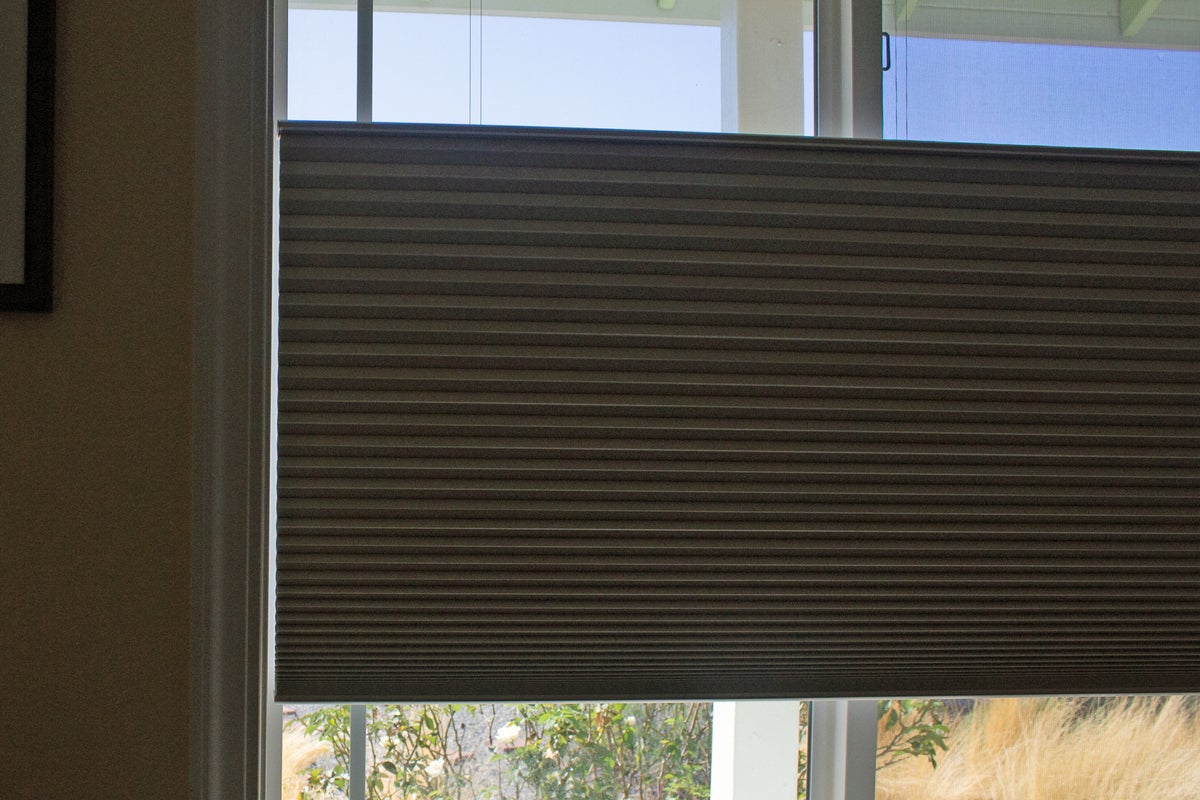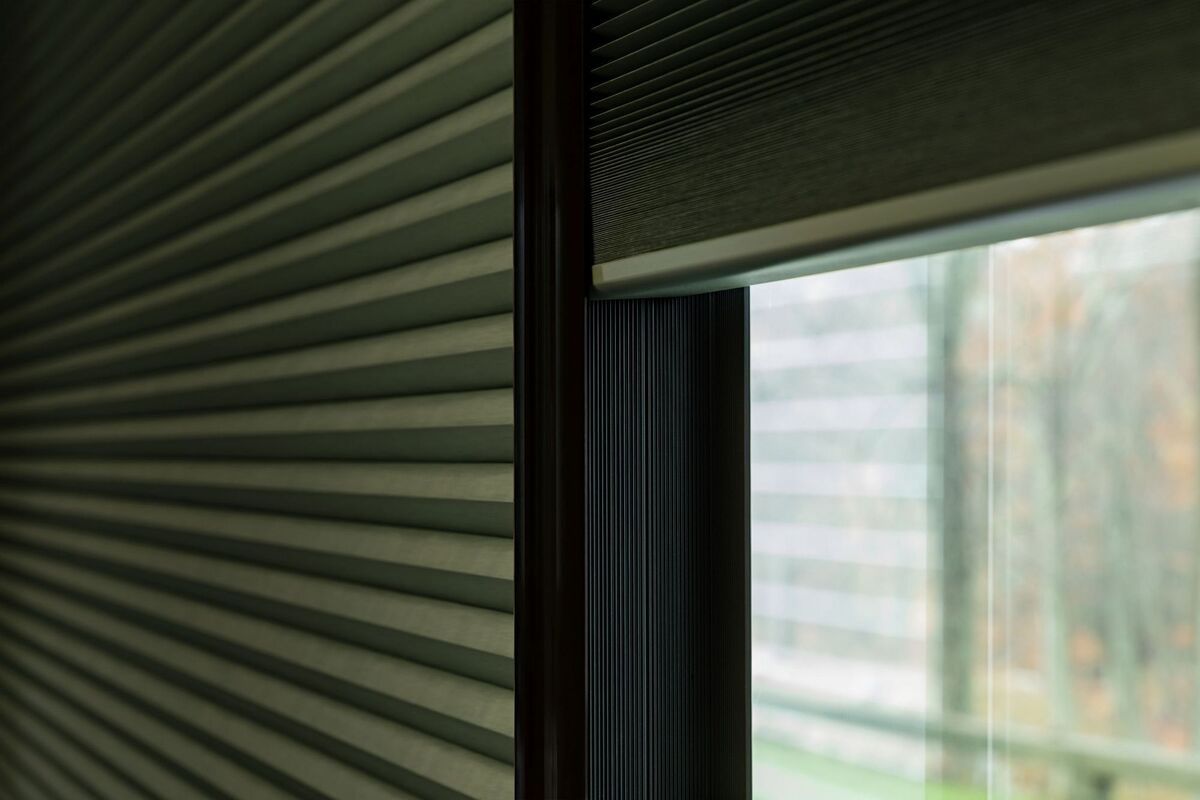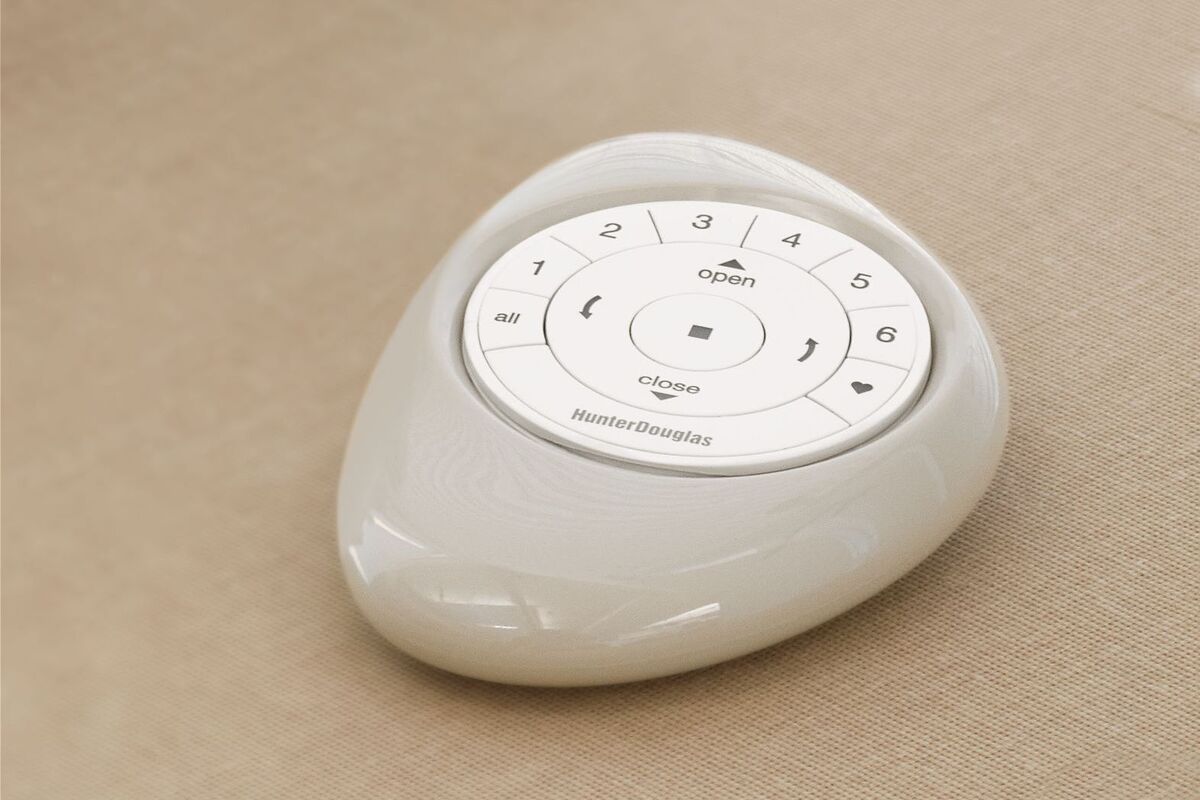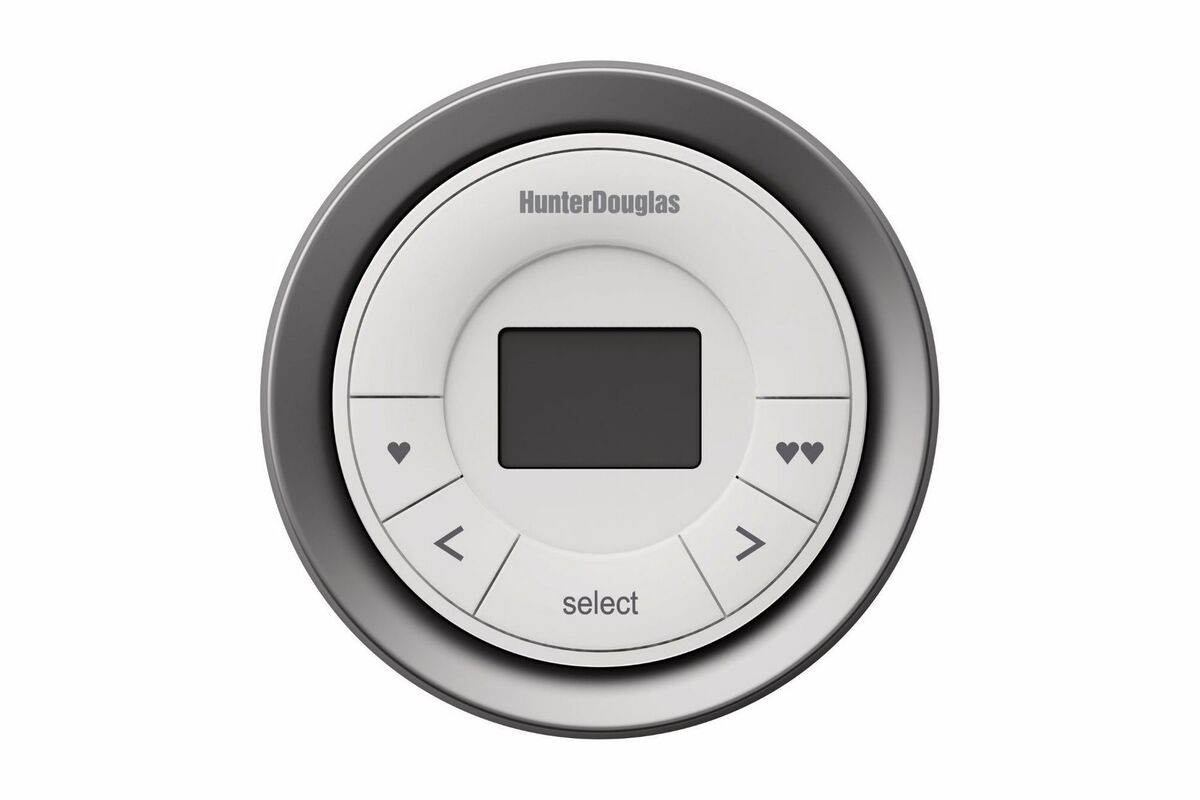The primary appeal of motorized top-down/bottom-up shades is their ability to open and close in two directions: They can open by dropping the top of the shade down from the window’s head to the sill, and by lifting the bottom of the shade up from the sill to the head. But Hunter Douglas couldn’t justify the lofty price tag of its Duette with PowerView Automation shades unless they were also the most luxurious and innovative shades we’ve reviewed to date.
Top-down/bottom-up shades are a fantastic option because they enhance privacy without completely blocking light from entering the room. If your window faces a busy street, you can lower the shade down from the top to admit light without exposing your room to a view from the street. Or you can drop the top of the shade down in the early morning, so the room is bathed in morning sunlight without impeding your ability to move about the room freely—anyone looking toward your window will only be able to as much of you as you wish to expose. And since these are motorized smart shades, you can create automated schedules to reposition the shades as many times each day and night that you’d care to program, including at sunrise and sunset.
This review is part of TechHive’s coverage of the best smart shades, where you’ll find reviews of competing products, plus a buyer’s guide to the features you should consider when shopping for this type of product.
 Michael Brown / IDG
Michael Brown / IDG
Hunter Douglas’ Duette honeycomb shades with PowerView automation can open from the top down, the bottom up, or both.
I had this shade installed in a guest room that has the same southern exposure as my home theater (where I have a Graber Virtual Cord Motorized Shade installed), so I selected Hunter Douglas’ Duette honeycomb shade with a room-darkening cellular fabric (there are a host of other options to choose from). Where Graber’s shades use two cells made with metalized fabric to enhance the fabric’s ability both to block light and to reduce heat transfer into the room, Hunter Douglas’ Duette shades use a cell-within-a-cell design consisting of fabric laminated to Mylar. Lutron, meanwhile, lines its cellular shades with aluminum, but like Hunter Douglas, offers only single-cell construction. Hunter Douglas says its design allows the cells in its shades to be larger—this shade has .75-inch cells, but 1.25-inch cells are an available option—while enhancing the shade’s energy efficiency and room-darkening ability.
Insulation and room darkening features
Using a Westward 1VER1 non-contact laser infrared thermometer, I recorded ambient temperatures 12 inches from the window with the shade open and then closed and saw a heat reduction of 6.5 degrees Fahrenheit with the shade closed. My master bathroom window, where I have a Lutron Serena honeycomb smart shade installed, and my home theater window, where I have the aforementioned Graber smart shade installed, all have the same southern exposure (albeit with different overhead eave widths), so I performed the same measurements in those rooms. The Serena shade reduced the ambient temperature at one foot by 3.5 degrees, but the double-celled Graber shade slashed it by 13.5 degrees.
 Michael Brown / IDG
Michael Brown / IDG
The honeycomb-like cells in Hunter Douglas’ Duette shades reduce heat transfer into the room. The room-darkening shade shown here features fabric laminated to Mylar.
All three shades did an excellent job of darkening the rooms they’re installed in, although there was some light leakage around the edges in each case, because I chose to install them inside the window frame. This wouldn’t have been an issue had I chose an outside mount, but I didn’t want to cover up the decorative molding that’s around all the windows in my house.
That said, the Hunter Douglas leaked the least amount of light at its top rail, and Hunter Douglas also offers an added-cost option that will significantly ameliorate the issue: The company’s LightLock system consists of U-shaped side channels that mount to the window sill and the left and right window jambs. The company says micro ridges on these panels absorb and deflect incoming light, and that the bottom panel overlaps the front and back of the shade’s bottom rail and feature magnets to create a secure closure. I did not evaluate this option, which adds $35 per foot for the vertical panels and $8 per foot for the bottom panel (prices are determined by the length and width of the shade). If I were installing this shade in my home theater, I would spring for the additional cost.
 Hunter Douglas
Hunter Douglas
Hunter Douglas’ LightLock system is designed to prevent light from leaking around shades mounted inside the window frame.
Power options
The Hunter Douglas shade looks better when viewed from outside the window than Graber’s shade does, but the optional panel you can buy for Lutron’s Serena shade completely hides its mounting hardware. And Lutron’s battery compartment is inside the headrail—accessible from the front—so you don’t see that, either. Hunter Douglas shades can be hardwired for power or they can run on battery power, with two options available. You can purchase a battery pack that uses alkaline batteries, but the better choice is the company’s rechargeable “battery wand.” This mounts to the back of the shade’s headrail, much like the battery pack on Graber’s shade, but a magnet secures the battery to its socket. When you need to replace a dead battery, you just reach up, pluck it out, and then snap in a freshly charged replacement.
 Michael Brown / IDG
Michael Brown / IDG
The battery wand is held in place with magnets and is supremely easy to replace when you need to swap it for a freshly charged one.
The battery wand isn’t the cheapest solution—it adds $65 to the price of the shade if you choose it as the power source—and the battery-charger options cost extra. It is, however, the most sophisticated power solution I’ve seen in this space. There’s a $50 charger that connects directly to the mounted shade, which means you’ll see a dangling wire while you recharge the battery. The $95 Dual Charging Station that Hunter Douglas provided with this review unit is a far more elegant solution. You can put it anywhere there’s an electrical outlet, and it can charge two battery wands simultaneously. Spare batteries cost $70 each, so for a combined cost of $135, you’ll never need to worry about not being to operate the shade due to a dead battery. The charging station is even more useful if, as will be likely, you have more than one shade installed in your home.
 Hunter Douglas
Hunter Douglas
These battery wands, shown here plugged into the dual charger, are the most elegant power solution we’ve seen for motorized shades.
Speaking of power, this is a good time to discuss how much noise Hunter Douglas’ shade motor produces during operation. I registered an 8.85dB increase in noise level while the shade was opening from fully closed to fully open, compared to an 8.3dB increase for the Lutron Serena shade, and a 9.6dB increase with the Graber shade. Bottom line: All three shades operate very quietly, and none of them are likely to wake you from a slumber, but Lutron’s product is the quietest of the three. The Powershades TruePoE shade, which utilizes power over ethernet instead of batteries, has a considerably louder motor. It’s very fast, but I registered a 16dB increase in noise with that product.
Smart home integrations
Hunter Douglas’s PowerView smart home integrations run the gamut from DIY (IFTTT, Logitech Harmony Home, and Apple HomeKit) to professionally installed (including Control4, Crestron, Elan, and Savant). You can also control them via voice commands (Amazon Alexa, Apple Siri, and Google Assistant), but you’ll need the company’s $285 PowerView hub, even if you only intend to use its own remote controls (more on those in a bit).
The hub creates a proprietary network using spectrum in the 2.4GHz frequency range. If you have a large home, Hunter Douglas offers signal repeaters that extend the PowerView hub’s reach. These plug into any outlet and provide the added benefit of an LED nightlight that casts a pool of light on the floor below it. Graber’s Z-Wave-powered smart shades can be controlled by most any Z-Wave-compatible smart home hub (e.g., Samsung SmartThings, for example, or the Vivint Smart Home system I use) or the company’s own $180 Z-Wave hub. Lutron’s Serena shades, meanwhile, depend on Lutron’s $80 Caséta Smart Bridge.
 Hunter Douglas
Hunter Douglas
The PowerView hub can connect to your router wirelessly or via an ethernet cable.
The sophistication of Hunter Douglas’ motorized shade offering comes to the fore when you consider the two types of circular remote controls it offers, each of which comes in either a handheld or wall-mount form factor (technically speaking, there are four remotes to choose from). The company provided the handheld variants—the PowerView Pebble and the PowerView Pebble Scene Controller—for this review. The wall-mount versions are the same devices as the handheld units, but they’re fitted into sockets that attach to the wall. These remotes have the word “Surface” appended to their names. All the remotes operate on two CR2032 coin cell batteries.
 Hunter Douglas
Hunter Douglas
Each Pebble remote control can control up to six groups of Hunter Douglas PowerView motorized shades, manually or via pre-programmed scenes.
Programming the PowerView Pebble remote ($70) entails first arranging all the shades in your home into groups, using Hunter Douglas’ PowerView app (available for Android and iOS), and then assigning each group to one of six buttons arranged in a half circle around the edge of the remote. If you have a large number of shades, you can deploy multiple remotes on the same network. You can also deploy multiple remotes with the same functions, so you can leave them in different rooms. To control a group of shades, you press the numbers that represent them: group 1 only, any combination (groups 1, 3, and 6; for instance), or “all” to select all the shades in the house. The group numbers on the remote will light up to indicate they’ve been selected.
You can now open or close all the shades in that group, or you can raise them from the bottom up or down from the top. A button in the middle of the remote stops whatever action has been initiated, and a heart button can be programmed to recall a favorite scene involving one or multiple shades. The $100 PowerView Scene Controller can also control one or many shades, but it’s outfitted with an LCD display that shows the names of the scenes you’ve created in the app. Pressing the left and right arrow keys scrolls through the scenes, and pressing the Select button activates them. You can also program two favorite scenes and activate them with one-touch heart buttons.
 Hunter Douglas
Hunter Douglas
The Pebble Scene Controller Surface is designed to be mounted to a wall. The LCD display shows which scene will occur when you press the Select button.
Prices and bottom line
Hunter Douglas’ PowerView Duette are the most expensive motorized shades we’ve reviewed. They’re also the most luxurious and the most sophisticated. The top-down/bottom-up feature is a boon to privacy, the battery-wand option is supremely convenient, and the remote-control options are fabulous. When you consider the price tag, which I’ll get to in a moment, remember that it includes a professional consultation to determine your wants and needs; having a technician come to your home to perform all the measurements; and then having them come back several weeks later to install the shades, program your hub and remote controls, and orient you to how everything works. There is no DIY option available, and Hunter Douglas does not sell direct to consumers—you’ll need to work with one of its dealers or an authorized smart home system integrator.
The 58 x 58-inch shade supplied for this review costs $1,274, including the motorization option. The PowerView Hub required for smart home integration costs an additional $285, the wireless repeater is another $60, and the Pebble remote and scene controller go for $70 and $100 respectively. That brings the total cost for this project to an eye-popping $1,789. Realistically, however, I could have easily done without the remotes (a smart speaker would’ve worked just as well) and the repeater (which I didn’t need anyway, given that the room where I installed the shade is directly across from the room where my network home run—and the PowerView hub—are located). That would bring the real-world cost for the shade and the hub down to $1,559. That equates to about $22 per inch (widthwise) compared to the self-installed options we’ve reviewed to date: $10 per inch for the Graber Virtual Cord, $13 per inch for the Powershade TruePoE, and $14 per inch for the Lutron Serena. (The cost of hubs, remotes, and other options is not included in my per-inch calculations to make apples-to-apples comparisons.)
Clearly, having someone else measure and install the shades costs a lot. On the other hand, having someone else perform those steps means you’re off the hook if they make an expensive mistake during either step. I’ve measured three of my home’s windows and installed new treatments so far and have yet to goof, but that doesn’t mean I’ve stopped stressing about it—even now that I’ve graduated to using a laser measure for the task. Knowing a mistake will waste several hundred dollars will do that to you.
But for many people, knowing the DIY route can save several hundred dollars is all the motivation needed to get over any lingering insecurity. And there are plenty of other people who just have more confidence in their DIY skills. It’s also worth noting that the manufacturers of each of the other smart shades we’ve reviewed offer the option of ordering through a dealer with professional installation.
The real bottom line is that you’ll need to decide which camp you’re in and how much convenience, luxury, and sophistication are worth to you. As for me, I think the higher cost of the Hunter Douglas product is justified.
October 26, 2020 at 05:00PM
https://ift.tt/2TnotkW
Hunter Douglas Duette PowerView review: luxury sophistication privacy - TechHive
https://ift.tt/2WinW4G
Bagikan Berita Ini

















0 Response to "Hunter Douglas Duette PowerView review: luxury sophistication privacy - TechHive"
Post a Comment